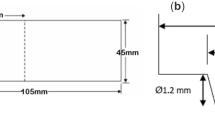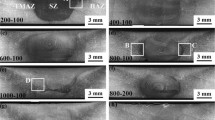Abstract
This paper focuses on the mechanism of onion rings emergence by analyzing optical macrographs and micrographs of friction stir welds on the copper alloy produced by a non-threaded tool pin. Also tensile tests, hardness measurements, and microstructural evaluations were performed on the welded specimens. The microstructural study shows that the weld has lamellar structure and the bands are sections of weld layers, which are produced by forward and rotational movement of the tool. The weld layers with same form, similar to the pin form, reside into each other with tool rotation and form a quasi-spherical shape. On the transverse cross section of the weld, the boundary of the layers is emerged like concentric quasi-circles, which are called onion rings. Each layer is emerged with one tool rotation, and its distance with the next consecutive layer is equal to the weld pitch. The formation of onion ring structures is due to the cutting of the weld layers with the same recesses and dimples. Hardness measurements show that the core of onion-ring-shaped structure at two points near the weld surface and weld root possesses maximum hardness. The average hardness of weld decreases from upper surface toward bottom until mid-depth, where then increases. HAZ has lower hardness on RS compared to that of AS. The scanning microhardness evaluation technique can be used as a complement method to the conventional hardness measurement procedures.
Similar content being viewed by others
References
Thomas WM, Nicholas ED, Needham J.C, Murch MG, Temple smith P, Dawes CJ (1991) Friction-stir butt welding’, GB Patent No: 9125978.8, International patent No: PCT/GB92/02203
Biallas G, Braun R, Dalle Donne C, Staniek G, Kaysser WA (1999) Mechanical properties and corrosion behaviour of friction stir welded 2024-T3, Proc. 1st Int. Symposium on ‘friction stir welding’, Thousand Oaks, California, USA, 14–16
Dalle Donne C, Biallas G (1998) Fatigue and fracture performance of friction stir welded 2024-T3 joints’, Proc. European Conf. on ‘Spacecraft Structures, Materials and Mechanical Testing’, Brauschweig, Germany, 4–6 November 1998 (ESA SP-428, February 1999,pp 309–314
Magnusson L, Kallman L (2000) Mechanical properties of friction stir welds in thin sheet of aluminium 2024, 6013 and 7475, Proc. 2nd Int. Conf. on ‘friction stir welding’, Gothenburg, Sweden, pp 26–28
Kumar K, Kailas SV (2008) The role of friction stir welding tool on material flow and weld formation. Mater Sci Eng A485:367–374
Krishnan KN (2002) On the formation of onion rings in friction stir welds. Mater Sci Eng A327:246–251
Schneider JA, Nunes-Jr AC (2004) Characterization of plastic flow and resulting microtextures in a friction stir weld. Metall Mater Trans B 35B:777–783
Vilaca P, Quintino L, Santos JF (2005) iSTIR—analytical thermal model for friction stir welding. J Mater Process Tech 169:452–465
Attallah MM, Davis CL, Strang Wood M (2007) Influence of base metal microstructure on microstructural development in aluminium based alloy friction stir welds’. Sci Technol Weld Join 12:361–369
Xie GM, Ma ZY, Geng L (2007) Development of a fine-grained microstructure and the properties of a nugget zone in friction stir welded pure copper’. J Scripta Mater 57:73–76
Xu S, Deng X (2008) A study of texture patterns in friction stir welds’. Acta Mater 56:1326–1341
Chen ZW, Cui S (2008) On the forming mechanism of banded structures in aluminium alloy friction stir welds’. J Scripta Mater 58:417–420
Cui GR, Ma ZY, Li SX (2008) Periodical plastic flow pattern in friction stir processed Al–Mg alloy. J Scripta Mater 58:1082–1085
Gerlich A, Su P, Yamamoto M, North TH (2008) Material flow and intermixing during dissimilar friction stir welding. Sci Technol Weld Join 13:254–264
Nandan R, DebRoy T, Bhadeshia HKDH (2008) Recent advances in friction-stir welding—process, weldment structure and properties. Prog Mater Sci 53:980–1023
Pashazadeh H, Masumi A, Teimurnezhad J (2013) Numerical modelling for the hardness evaluation of friction stir welded copper metals. Mater Des 49:913–921
Pashazadeh H, Masumi A, Teimurnezhad J (2013) A study on material flow pattern in friction stir welding using finite element method. Proc IMechE Part B 227:1453–1466
Pashazadeh H, Masumi A, Teimurnezhad J (2014) Numerical investigation on the mechanical, thermal, metallurgical and material flow characteristics in friction stir welding of copper sheets with experimental verification. Mater Des 55:619–632
Gheisari Y, Pashazadeh H, Teimurnezhad J, Masumi A (2014) Weld defect formation in FSWed coppers. J Mat Eng Per 23:2000–2006
Zhao Y, Ye Y, Yan K, Zhou L (2012) Microstructure and mechanical properties of friction stir welding joint of pure copper. Adv Mater Res 418:1520–1523
Khodaverdizadeh H, Mahmoudi A, Heidarzadeh A, Nazari E (2012) Effect of friction stir welding (FSW) parameters on strain hardening behavior of pure copper joints. Mater Des 35:330–334
Surekha K, Els-Botes A (2011) Development of high strength, high conductivity copper by friction stir processing. Mater Des 32:911–916
Li X, Zhang D, Qiu C, Zhang W (2011) Effect of processing parameters on microstructure and mechanical properties of pure copper joints made by friction stir welding. Trans China Weld Inst 32:93–96
Xue P, Xiao BL, Zhang Q, Ma ZY (2011) Achieving friction stir welded pure copper joints with nearly equal strength to the parent metal via additional rapid cooling. Scr Mater 64:1051–1054
Sun YF, Fujii H (2010) Investigation of the welding parameter dependent microstructure and mechanical properties of friction stir welded pure copper. Mater Sci Eng A 527:6879–6886
Shen JJ, Liu HJ, Cui F (2010) Effect of welding speed on microstructure and mechanical properties of friction stir welded copper. Mater Des 31:3937–3942
Liu HJ, Shen JJ, Huang YX, Kuang LY, Liu C, Li C (2009) Effect of tool rotation rate on microstructure and mechanical properties of friction stir welded copper. Sci Technol Weld Join 14:577–583
Lin JW, Chang HC, Wu MH (2014) Comparison of mechanical properties of pure copper welded using friction stir welding and tungsten inert gas welding. J Manuf Process 16(2):296–304
Cam G, Mistikoglu S, Pakdil M (2009) Microstructural and mechanical characterization of friction stir butt joint welded 63% Cu-37% Zn brass plate. Weld J 88(11):225–232
Teimournezhad J, Masoumi A (2010) Experimental investigation of onion ring structure formation in friction stir butt welds of copper plates produced by non-threaded tool pin. Sci Technol Weld Join 15(2):166–170
Andersson CG, Andrews RE (1999) Fabrication of containment canisters for nuclear waste by friction stir welding, In: Proceedings of the First International Symposium on Friction stir welding, Thousand Oaks, CA, USA pp 14–16
Andersson CG, Andrews RE, Dance BGI, Russell MJ, Olden EJ, Sanderson RM (2000) A comparison of copper canister fabrication by the electron beam and friction stir processes, in: Proceedings of the 135 Second International Symposium on Friction stir welding, Gothenburg, Sweden pp 26–28
Hautala T, Tiainen T (2002) Friction stir welding of copper. In: Proceedings of the Sixth International Conference on Trends in welding research, Georgia. ASM International, USA, pp 324–328
Lee WB, Jung SB (2004) The joint properties of copper by friction stir welding. Mater Lett 58:1041–1046
Okamoto K, Doi M, Hirano S, Aota K, Okamura H, Aono Y, Ping TC (2001) Fabrication of backing plate of copper alloy by friction stir welding, in: Proceedings of the Third International Symposium on Friction stir welding, Kobe, Japan
Park HS, Kimura T, Murakami T, Nagano Y, Nakata K, Ushio M (2004) Properties of friction stir welds of 60%Cu-40%Zn copper alloy. Mater Sci Eng A377:160–169
Meran C (2006) The joint properties of brass plates by friction stir welding. Mater Des 27:719–726
Andersson HCM, Seitisleam F, Sandstrom R (2005) Swedish Nuclear Fuel and Waste Management Co (SKB), Technical Report: TR-05-08 (January 2005)
Muller C, Elaguine M, Bellon C, Ewert U, Zscherpel U, Scharmach M, Redmer B (2006) POD (Probability Of Detection) Evaluation of NDT Techniques for Cu-canisters for risk assessment of Nuclear Waste Encapsulation, In: Proceedings of the European Conference on Nondestructive Testing (ECNDT) 2006-Fr.2.5.1, BAM-Federal institute for materials research and testing, Berlin, Germany and SKB-Svensk Karnbranslehantering AB; Oskarshamn; Sweden
Xie GM, Ma ZY, Geng L (2007) Development of a fine-grained microstructure and the properties of a nugget zone in friction stir welded pure copper. Scr Mater 57:73–76
Sakthivel T, Mukhopadhyay J (2007) Microstructure and mechnical properties of friction stir welded copper. J Mater Sci 42:8126–8129
Author information
Authors and Affiliations
Corresponding author
Rights and permissions
About this article
Cite this article
Pashazadeh, H., Teimournezhad, J. & Masoumi, A. Experimental investigation on material flow and mechanical properties in friction stir welding of copper sheets. Int J Adv Manuf Technol 88, 1961–1970 (2017). https://doi.org/10.1007/s00170-016-8913-9
Received:
Accepted:
Published:
Issue Date:
DOI: https://doi.org/10.1007/s00170-016-8913-9




